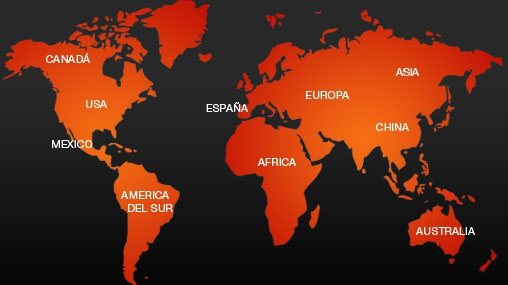- Inicio Acerca de RM Minerales
- Galería de fotos Blog RM Contacto
- Microscopia e instrumentos Pedidos Aviso legal
Copyright 2010-2025
www.rosellminerals.com



Nutrido grupo de cristales prismáticos hexagonales de piromorfita, ligeramente abarrilados, con brillo, y color que varía entre el verde amarillento en la parte media y verde claro en las caras terminales. Este ejemplar procede de una colección alemana.
Grupo de cristales cúbicos de fluorita, de color púrpura a violeta, según la luz incidente. Caras y aristas bien definidas, brillo y transparencia. En la parte posterior se hallan parcialmente recubiertos de microcristales de cuarzo.
De una localidad clásica alemana y de conocidos coleccionistas como Joan Viñals y Emili Nicolau, nos llega este ejemplar de bismuto nativo, de peso: 293 g. Podemos ver en sussuperficie numerosas hendiduras formadas por cristales arborescentes de bismuto. Un ejemplar con historia, recomendado para coleccionistas de los "grises".
Cristales idiomórficos de cerusita, ricos en caras, con brillo, translúcidos y con intensa respuesta bajo la luz UVOL. Sobre una matriz de cristales de barita.
Sobre una matriz de dolomita se disponen numerosos cristales tabulares de wulfenita, definidos y que muestarn caras de la bipirámide y los pinacoides basales. Color amarillo anaranjado. De esta localidad clásica marroquí. Procede de la colección J. Murria de Barcelona.
Recientemente han aparecido en el mercado ejemplares de escapolita de origen marroquí. Los análisis que hemos realizado de varios ejemplares nos indican que se trata de marialita, ya que la proporción de Na (marialita, Na₄Al₃Si₉O₂₄Cl) es superior a la de calcio (meionita, Ca₄Al₆Si₆O₂₄CO₃), además se detecta la presencia de cloro. Podemos observar que la proporción de Ca es bastante alta por lo que nos encontramos en un término medio de la serie marialita-meionita.
Los cristales se presentan como prismas tetragonales truncados por el pinacoide basal y la bipirámide de primer orden. Transparentes a translúcidos y algunas inclusiones. Presentan cierta fluorescencia bajo la lus UV-OL. Enviaremos los análisis al comprador.
Recientemente han aparecido en el mercado ejemplares de escapolita de origen marroquí. Los análisis que hemos realizado de varios ejemplares nos indican que se trata de marialita, ya que la proporción de Na (marialita, Na₄Al₃Si₉O₂₄Cl) es superior a la de calcio (meionita, Ca₄Al₆Si₆O₂₄CO₃), además se detecta la presencia de cloro. Podemos observar que la proporción de Ca es bastante alta por lo que nos encontramos en un término medio de la serie marialita-meionita.
Los cristales se presentan como prismas tetragonales truncados por el pinacoide basal y la bipirámide de primer orden. Transparentes a translúcidos y algunas inclusiones. Presentan cierta fluorescencia bajo la lus UV-OL. Enviaremos los análisis al comprador.
Los cristales de monazita de Madagascar son famosos en el mundo entero. Las localidades son múltiples. Este ejemplar que ofrecemos se acompaña de una etiqueta de Deyrolle (París). La compañía Deyrolle inició su andadura en 1831, de la mano de Jean-Baptiste Deyrolle, con la elaboración y venta de materiales relacionados con las ciencias naturales. Este ejemplar se acompaña de una etiqueta manuscrita por ambos lados.
La pieza es excepcional. Se trata de cristales maclados de monazita-(Ce), con caras y aristas definidas, brillantes y con un color marrón, más oscuro en los prismas. Sobre una de las caras un crecimiento escalonado. El tamaño es muy notable. Ejemplares d eesta magnitud no se ven a menudo...
Los nódulos de tinticita de las minas de Bruguers són quizás de los más característicos de la especie. Se hallan de dos maneras; unas veces en la roca dolomitica, dura, lo que permite ver secciones de los mismos, y en otras en una matriz de limonita, que permite observar la forma arriñonada de los mismos, e incluso extraerlos sin dificultat. Recomendamos visitar el libro que recientemente publiqué sobre esta famosa mina catalana: Mines i minerals de la serra de les Ferreres. Les mines de Rocabruna, Bruguers, Gavà, el Baix Llobregat, Catalunya.
Los nódulos de tinticita de las minas de Bruguers són quizás de los más característicos de la especie. Se hallan de dos maneras; unas veces en la roca dolomitica, dura, lo que permite ver secciones de los mismos, y en otras en una matriz de limonita, que permite observar la forma arriñonada de los mismos, e incluso extraerlos sin dificultat. Recomendamos visitar el libro que recientemente publiqué sobre esta famosa mina catalana: Mines i minerals de la serra de les Ferreres. Les mines de Rocabruna, Bruguers, Gavà, el Baix Llobregat, Catalunya.
Los nódulos de tinticita de las minas de Bruguers són quizás de los más característicos de la especie. Se hallan de dos maneras; unas veces en la roca dolomitica, dura, lo que permite ver secciones de los mismos, y en otras en una matriz de limonita, que permite observar la forma arriñonada de los mismos, e incluso extraerlos sin dificultat. Recomendamos visitar el libro que recientemente publiqué sobre esta famosa mina catalana: Mines i minerals de la serra de les Ferreres. Les mines de Rocabruna, Bruguers, Gavà, el Baix Llobregat, Catalunya.
Sobre una matriz de goethita, con formas estalactíticas y botroidales, se disponen diversos agregados de cristales tabulares a prismáticos de vivianita. Muy aéreos, de color verde muy intenso, casi negro, con brillo y reflejos verdes. Muy buen ejemplar para la especie.
Muy rico ejemplar formado por numerosos cristales prismáticos de vesuvianita, brillantes, transparentes y de un tono verdoso suave. Muy estético especímen y de buen tamaño. Esta famosa mina de asbestos-crisotilo a cielo abierto, de unos 2 km de diámetro y con una profundidad de hasta 350 m. comenzó a explotarse en 1879. La demanda mundial de amianto se redujo drásticamente en la década de 1980, cuando se conocieron sus propiedades cancerígenas y se prohibió su uso como material de construcción a nivel mundial. En 1996, en un intento por explotar una zona de alta calidad en el fondo de la mina, se intentó nuevamente cambiar a métodos subterráneos, pero los subsidios gubernamentales se agotaron en 2001, y desde entonces la mina ha permanecido inactiva.
Un ejemplar de estibnita de esta clásica localidad alemana. La pieza procede de la colección Coune (Bélgica) y fue incorporada a principios delos 70. Se trata de una agregado radial de cristales aciculares de este sulfuro de antimonio. Se dispone sobre una matriz con cristales de pirita, cuarzo y de calcita.
Un ejemplar de muy buen tamaño de este raro silicato de tierras raras: chevkinita-(Ce), procedente del mejor descubrimiento mundial para la especie. Esta remota localidad pakistaní comenzó a producir estos magníficos ejemplares a finales de la década de 1990, principios de los 2000. Este grupo muestra cristales euhedricos, definidos, facetados y con caras terminales negras, bastante brillantes, que miden hasta 4,5 cm sobre una matriz de chevkinita-(Ce). De los ejemplares de A. Petrov. Una pieza excepcional.
Pequeños cristales anaranjados a amarillos de kasolita, muy estéticos bajo aumento. Se disponen sobre una matriz de gres con malaquita. Un clásico de Musonoi.
Los ejemplares uraníferos de esta mina mexicana situada al norte de Chihuahua son poco habituales en el mercado. En este especimen podemos ver numerosos cristales aciculares de este silicato de uranilo, con brillo, transparencia y un color intenso. Se disponen en cavidades en la calcita.
Muy estético ejemplar formado por cristales de malaquita primaria, muy brillantes y de color verde oscuro. Los cristales tienen una apariencia triangular a romboédrica debido a la forma en que se han intercrecido y presentan un verde más brillante en los bordes. Es bastante raro encontrar cristales primarios de malaquita, especialmente con cristales definidos, siendo esta mina por producir estas malaquitas. El ejemplar venía etiquetado como "libethenite" (sic), por supuesto lo analizamos (análisis RM308), aunque una gota de HCl ya hubiera servido para descartar el fosfato, pero...
Habitaulmente los ejemplares de malaquita de esta mina aparecen sin matriz. Este ejemplar nos muestra un agregado botroidal de intenso color verde que se dispone de forma muy aérea sobre una matriz de cuarzo. Muy estético.
Muy interesantes ejemplares donde la cianita sustituye a la quiastolita, una variedad de andalucita, en una matriz grafítica. El ejemplar presenta características asociadas a la andalucita preexistente, como macla, indicada por las dos orientaciones diferentes de la cianita que la reemplaza. Se acompaña de cristales melados prismáticos de quiastolita. Se han analizado. Para los amantes de las pseudomórfosis raras. Muy fluorescente (naranja) bajo la luz ultravioleta OL.
Muy interesantes ejemplares donde la cianita sustituye a la quiastolita, una variedad de andalucita, en una matriz grafítica. El ejemplar presenta características asociadas a la andalucita preexistente, como macla, indicada por las dos orientaciones diferentes de la cianita que la reemplaza. Se acompaña de cristales melados prismáticos de quiastolita. Se han analizado. Para los amantes de las pseudomórfosis raras. Muy fluorescente (naranja) bajo la luz ultravioleta OL.
Estos ejemplares proceden de la localidad tipo para la kolwezita, un carbonato de cobre y cobalto. La mayoría de las piezas de "kolwezita" que se ven en el mercado no tienen la relación 1:1 Cu:Co, que se exige para llamarlas así, suelen tener la relación Cu:Co 2:1. De todas las que he analizado (y van unas cuantas) incluso las de color verde oliva mantienen esa relación. En este caso podemos decir, para ser honestos, que se trata de malaquita rica en cobalto. Aún así, los ejemplares son muy estéticos. Si algún día encuentro una kolwezita 1:1 Cu:Co, probablemente hallaré el grial...
Estos ejemplares proceden de la localidad tipo para la kolwezita, un carbonato de cobre y cobalto. La mayoría de las piezas de "kolwezita" que se ven en el mercado no tienen la relación 1:1 Cu:Co, que se exige para llamarlas así, suelen tener la relación Cu:Co 2:1. De todas las que he analizado (y van unas cuantas) incluso las de color verde oliva mantienen esa relación. En este caso podemos decir, para ser honestos, que se trata de malaquita rica en cobalto. Aún así, los ejemplares son muy estéticos. Si algún día encuentro una kolwezita 1:1 Cu:Co, probablemente hallaré el grial...
Un ejemplar muy elegante formado por cristales tabulares apalnados, en crecimiento paralelo y divergentes, con el color gris metálico característico. Se acompaña de un cristal tabular de barita. De esta localidad clásica rumana.
